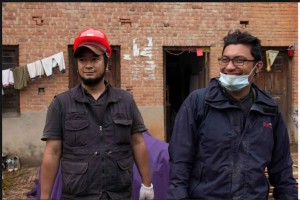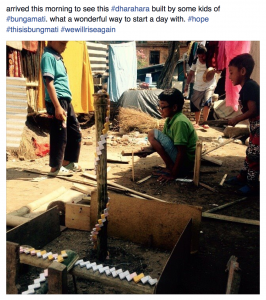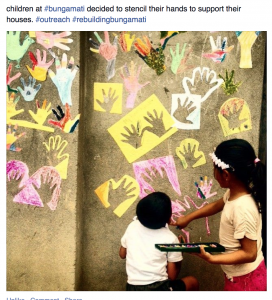Diary excerpts – not only Christiane’s – from Bungamati project :
6.5.2015 Today, the volunteers for the project Rebuilding Bungamati started their work. They did amazingly – 100 volunteers, including students and faculty from the Art & Design Department at Kathmandu University were divided into logistics team and equipment team, there is a documentation team and there are people looking after the children, providing them with pencils and paper, spending possibly the first leisure time, putting their thoughts and attention to something else but the aftermath of the earthquake. Sujan Chitrakar, professor and head of the department, has set up a restricted information forum to coordinate the work, and himself works day – and night – to inspire and keep the volunteers involved. He is accompanied by an ambitious team of colleagues, and roughly 90 students from 4 batches.
In one of his briefs to the volunteers, we can read how cautious he is about the initiative’s implications:
„some important points to keep in mind for today!!!! 1. people have gone through lots of hardship and loss. show empathy not sympathy. 2. before offering help, please ask for permission. some people may not like other people helping them. 3. do not sit around and laugh, joke or make fun of each other. for few days, just wear smile on your face. 4. people live in bungamati. any outsider are intruders. try to build rapport with the locals. ask what they need the most now. if you can offer right away, do offer. if not tell them, we might be able to connect with the concerned people/officials. 5. DO NOT GO CLEAN THE DEBRIS INSIDE ANY DAMAGED HOUSE/S. WE ARE NOT THE EXPERTS. 6. before you switch to a new job rather than assigned, do inform your volunteer coordinator /. 7. STICK WITH THE PLAN AND BE FOCUSED. DO NOT GO OVERBOARD AND LOOSE CONCENTRATION. PLEASE ADD UP OTHER IMPORTANT POINTS..“
The goal of building two shelters in one day has been reached, and more than that, all has been done in an amazingly positive TEAM spirit, encouraging, inspiring and positive.
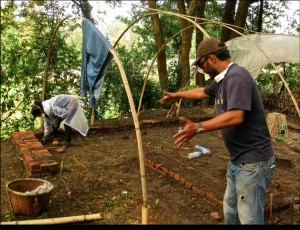 Sujan Chitrakar explaining the structure of one of the shelters they built on day 2 (photo: Nadine Plachta).
Sujan Chitrakar explaining the structure of one of the shelters they built on day 2 (photo: Nadine Plachta).
Day 2 (7.5.15) The volunteers make lists of tools needed for the next day, members of each group and how to reach them, they have now built a documentation unit that will also start a blog. As the evening falls, and we communicate, for instance, what is needed that friends could take on their journey to Nepal, we receive one message: we need construction gloves. They are getting out of stock in the valley. The last message for day 3 however is: „Lets meet up at 12 at Bungamati. I have called the team members of Research too. D*** will also join. We need the bloggers too. Need to brain-storm, focus and act. We have a long way to go. Volunteer Team!!!! please coordinate.“ With people like this, and there are so many all over Nepal, Nepal will rise! And we can learn how mountains can be moved, and hearts and souls motivated.
Members of KU arts&design department faculty (photo: S. Tamrakar)
Day 3 – 8.5.15 we now receive diverse declarations of interest and support – not only financial but also in terms of expertise with respect to the overburdening challenges that come along with the hope to rebuild many of the residential houses, but also the cultural and religious heritage that is important both for tourists, but more so for the local population whose lives – and personal as well as collective practices – are closely intertwined with these sites. A friend of our colleague, the architect Niels Gutschow (see Projekt on Lakyuphalcha in Bhaktapur) writes to me after reading about the ‘Rebuilding Bungamati’-initiative, and has kindly allowed me to share this in this report: “I am a member of a group surveying Bungmati in 1968. Your mail is the first news from Bungmati that we have. We have been preparing a publication for the Cooporative Society Bungmati. incl. drawings and photos. Do you think that mailing the drawings to someone now can be of help, and in case who? We have no contacts in the village at the moment. Will Prof. Sujan Chitakar be a possibility? In case, could you mail me his mail adr.? With best regards Jørgen Rahbek Thomsen”, and after being in touch with Sujan Chitrakar, he adds this: “The material we produced was measured drawings of townplan, parts of plan with sections and facades, our host familys house and courtyard, small street plan and facades, temple Square, temple front, diff. housetypes, monastery plan sec. and facades and afterwards we made isometric illustrations. Then we made a socio-economic survey using a questionnaire, giving info about family, caste, economy, landholdings etc. We also have a comprehensive photo documentation. Our plan was to hand over the whole material to the new Taragaon Museum, but I wonder if it has been damaged too.” This message underlines the relevance of this relief work and the ways it allows for networking: suddenly, old resources become not only relevant for documentation of a past for the museum or archive, but could well start its own new life in that it now serves as model for reconstruction and for the memory of something gone. 9.5.15:  Sameer Tanrakar posts this image today (click for better resolution), showing how much has been archieved in the past days – many activities also being outside the frame of this picture. The team is in full action, there seem to be two things people are occupied with: work and, if there is time, sleep. I hope they also get to rest inbetween. here is again what Sujan writes (names replaced by initials): „Sujan Chitrakar, 9 May at 10:39pm Tentative Plan (for 10.5., CB) NB and SDBa will pick up CGI sheets from Bhaktapur to arrive Bungamati at around 10am. BT, RT and ST will buy new chuck of bamboo for the new shelters. PBS will arrange mural in around ChohelNani. SS and his team will finish the prototype. DC, WS and his team will finish applying mud in shelter 1. D and his team finish fencing the second shelter. SL and construction team will start two large shelters. KMS and team finish the tarp partition. Gopal Kalapremi Shrestha and his team will finish the restroom and the septic tank. Sagar Manandhar, SRS and team will support P with the mural stuffs. SP to look at logistics. PT please coordinate all.
Sameer Tanrakar posts this image today (click for better resolution), showing how much has been archieved in the past days – many activities also being outside the frame of this picture. The team is in full action, there seem to be two things people are occupied with: work and, if there is time, sleep. I hope they also get to rest inbetween. here is again what Sujan writes (names replaced by initials): „Sujan Chitrakar, 9 May at 10:39pm Tentative Plan (for 10.5., CB) NB and SDBa will pick up CGI sheets from Bhaktapur to arrive Bungamati at around 10am. BT, RT and ST will buy new chuck of bamboo for the new shelters. PBS will arrange mural in around ChohelNani. SS and his team will finish the prototype. DC, WS and his team will finish applying mud in shelter 1. D and his team finish fencing the second shelter. SL and construction team will start two large shelters. KMS and team finish the tarp partition. Gopal Kalapremi Shrestha and his team will finish the restroom and the septic tank. Sagar Manandhar, SRS and team will support P with the mural stuffs. SP to look at logistics. PT please coordinate all.  DM will have to hunt for a room nearby for we need a space to coordinate and store our stuffs properly. NS will finalise the infographics and map for the municipality office.“ He continues: „AS will bring NP for Post-Trauma Workshop at around 10:30. (Addressing a group of people): support and document the workshop. Many people are concerned about the young lady consuming poison. We still have many people who could not come out the traumatic and near-to-death experiences. These sessions should be very therapeutic for all of us.“ 11.5.2015 I take the liberty to post a report by a volunteer to the „Rebuilding Bungamati“ project, sharing his impressions of the visit by Neeva Pradhan from the Daya Foundation to the town to engage with children and elderly from the displaced community through medical service and meditation/games. His view of the project’s volunteer dynamics but also the situation at the site is insightful. The report was posted on the restricted Rebuilding Bungamati facebook site. Christiane Brosius
DM will have to hunt for a room nearby for we need a space to coordinate and store our stuffs properly. NS will finalise the infographics and map for the municipality office.“ He continues: „AS will bring NP for Post-Trauma Workshop at around 10:30. (Addressing a group of people): support and document the workshop. Many people are concerned about the young lady consuming poison. We still have many people who could not come out the traumatic and near-to-death experiences. These sessions should be very therapeutic for all of us.“ 11.5.2015 I take the liberty to post a report by a volunteer to the „Rebuilding Bungamati“ project, sharing his impressions of the visit by Neeva Pradhan from the Daya Foundation to the town to engage with children and elderly from the displaced community through medical service and meditation/games. His view of the project’s volunteer dynamics but also the situation at the site is insightful. The report was posted on the restricted Rebuilding Bungamati facebook site. Christiane Brosius
Sanjeeb, thanks for sharing and for the touching write up! Felt very fortunate to see such dynamic team work and spirit. Beautiful group of Rebuilding Bungamati volunteer group and residents there!










17.5.2015 Rebuilding Bungamati is back in full swing.After the terrible experience of another earthquake on 12.5., the initiative resumes again, also knowing that time does not wait, that monsoon is approaching with unexpected speed and people need rays of hope not to give up. one of the impressive initiatives at Bungamati is that they work on the basis of local participation, in order to make the idea of reconstruction work, and in order to get people out of the state of panic and despair. It seems to work. The shelters (each of them around 10.000 Rupees, e.g, 100 Euro) are the prime focus for 15.5., but also the collection of data for future work in terms of rebuilding sustainable structures is crucial. This includes a focus on cultural and historical aspects of contexts related to Bungamati. Moreover, the work with children is continued. Motivation, after the ‘fall’ on 12th and 13th May, certainly gains speed. Shelters are built for small social units, mostly families, but also for single old couples without family. Thee volunteers now reach out and make plans for strategic construction of shelters, since almost everyone now, after the second earthquake, seems to be too scared to sleep in their houses, if at all they are still standing. Many lost their houses and their faith in them. Outdoor artwork such as murals is developed to encourage the local population, to cheer them up. The work with the kids goes on. Recreation for children seems vital.
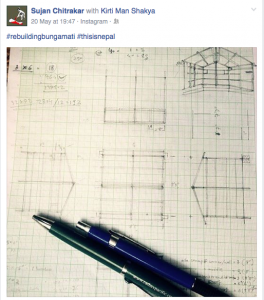
1.6.2015. Our initiative starts to blossom and we receive emails from various people, articulating their interest in helping and contributing to the projects. Such is the case with Roswitha Steinkopf, an artist from the North of Germany who worked with Sujan Chitrakar and his students in 2011. She writes:
„in der FAZ las ich Ihren langen Artikel über die Wiederaufbauarbeiten von Sujan Chitrakar und seinen Studenten in Bungamati. Sujan Chitrakar und seine Studenten 2011 habe ich als artist-in-residence in Patan während eines einmonatigen KunstProjektaufenthaltes kennengelernt. In meinem seit 2002 laufenden Projekt “What is art” habe ich Menschen auf der Strasse in verschiedenen Kontinenten der Welt diese Frage gestellt und tausende Antworten auf weißgestrichene Holztafeln schreiben lassen. In Nepal gaben die Antworten ein anderes Bild als sonst auf der Welt. Sie spiegelten das, was auch in Ihrem Artikel steht. Fünf Antworten mögen stellvertretend für viele stehen
Translation by CB: „I read your article in the FAZ concerning the reconstruction initiative by Sujan Chitrakar and his students in Bungamati whom I met at a one-month-long artist-in-residence stay in Patan in 2011. I conducted a project that rund since 2002, where I ask people on the streets in various parts of the world ‚what is art?‘, and then transferred their answers (thousands) onto white wooden panels, the answers from Nepal revealed a very different picture than anywhere in the world. They mirror what you reflect in the article, and I give 5 selected answers as an example:
“Each temple, each language reflects our culture and makes us famous. For us Nepali this is normal, but for the rest of the world this is precious and attractive. I am proud to be Nepali.” (Asita) “Art is part of people, civilization of people, reflection of culture. It is very important.” (S. Maharjan) “Art is a property of our country” (K. Dhakal) “The art is introducing the person. I work for handcraft and especially in statues. This is our work since generations and it represents our country.” Bikash, silversmith “Art shows our identity. It is demonstrated in our culture. (…) We have to preserve our own culture.“ (R. Shrestha) (…) Grund meines Schreibens/reason of my writing this:
Ich fühle mich Sujan Chitrakar und seinen Studenten sehr verbunden und möchte etwas zurückgeben. Dafür habe ich Geld gesammelt, das speziell ihm und seiner Aktion in Bungamati zugute kommen soll.“
translation: I feel very connected with Sujan Chitrakar and his students and want to return something. I collected money that should be dedicated only to him and his project in Bungamati.“ (Roswitha Steinkopf, email-conversation, 1.6.15)
9.6.2015: the student volunteers and faculty from Kathmandu University Art and Design department have made a blog where the proceedings of the initiative are regularly updated and documented.
15.6.15: One volunteer of the many still working at the site in Bungmati is Avash Shrestha, a graduate from Webster University Thailand campus who studied International Business with a minor in International Relations and now wants to proceed with Developmental Studies. He volunteered in the context of shelter construction but also just published a small report, his personal view of the Rebuilding Bungmati project here .
